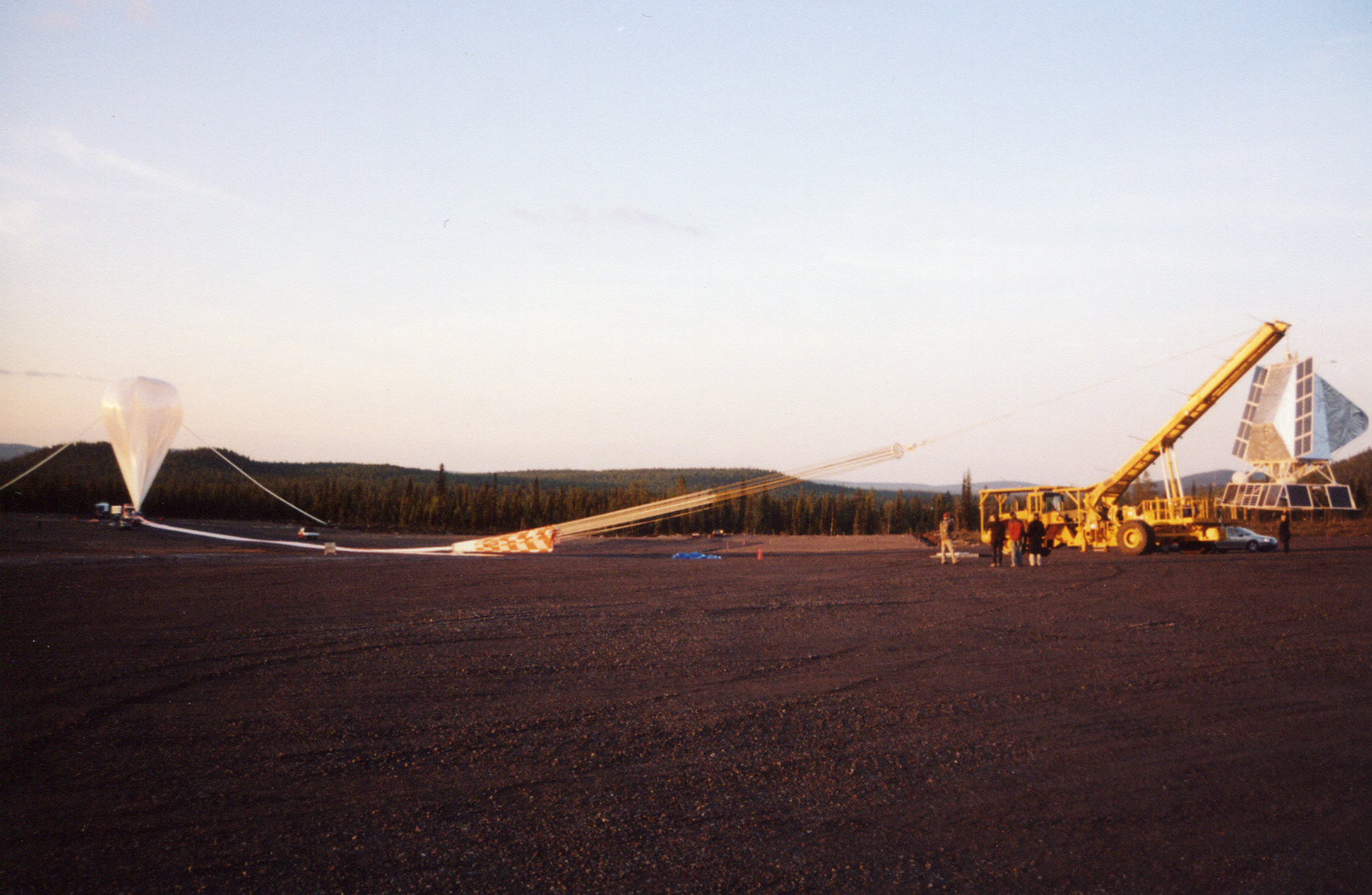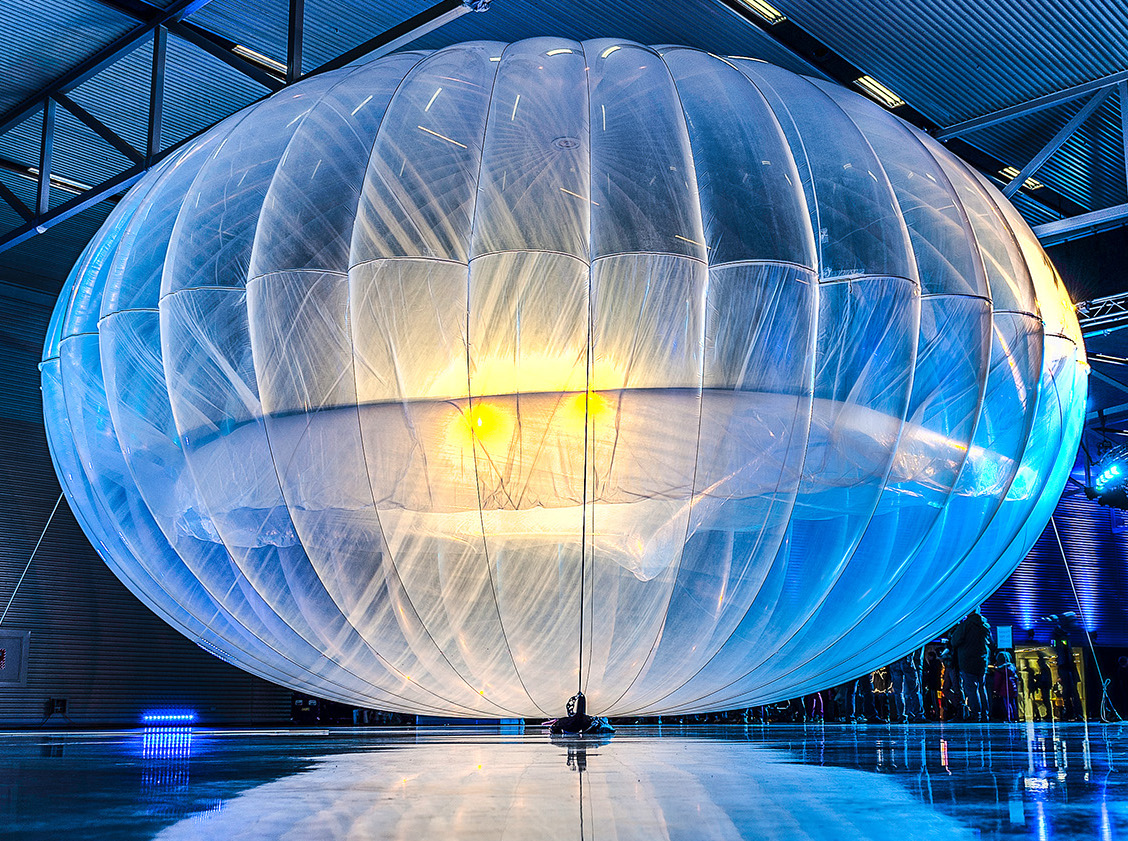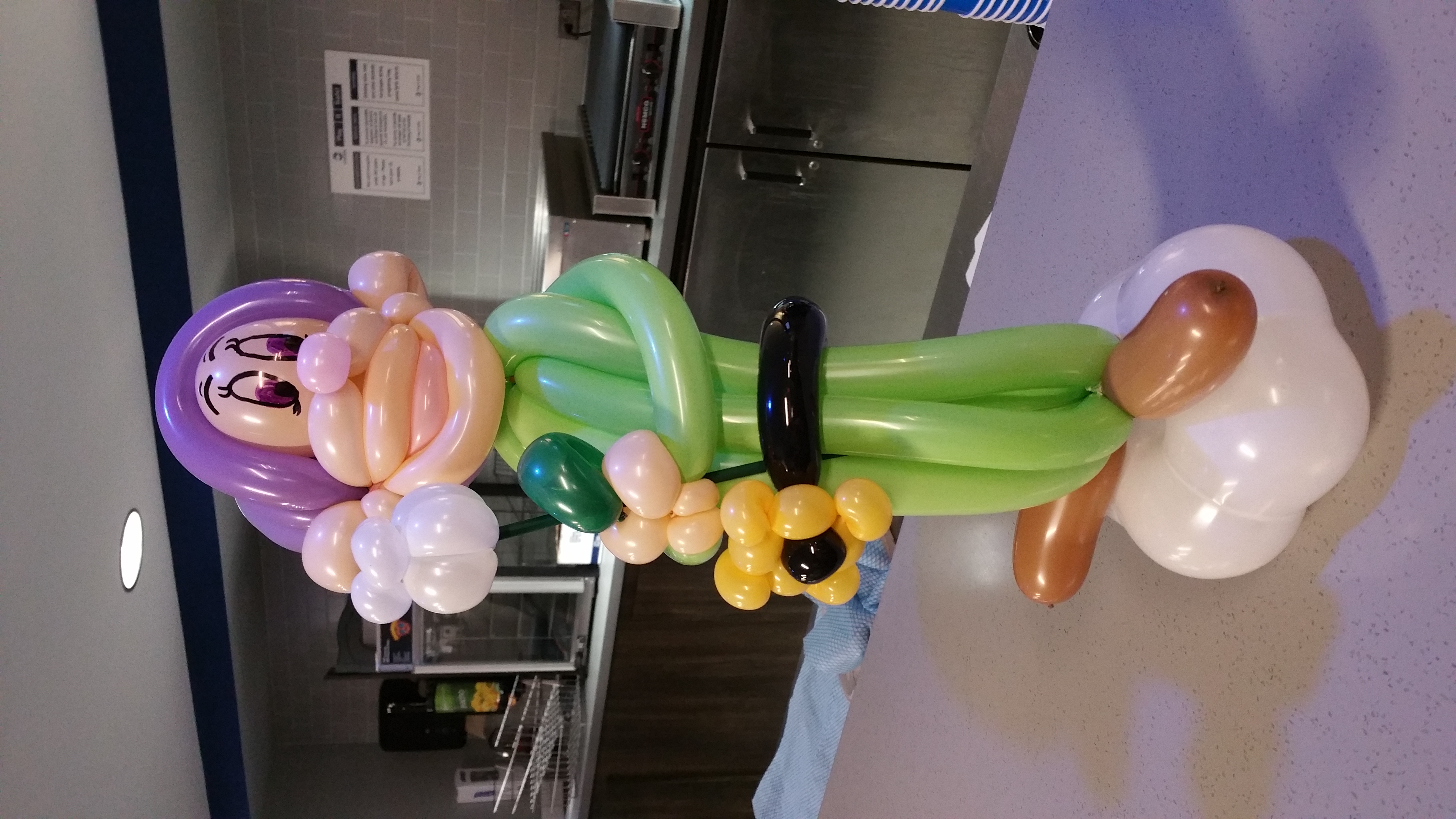|
Research Balloon
Research balloons are balloons that are used for scientific research. They are usually unmanned, filled with a lighter-than-air gas like helium, and fly at high altitudes. Meteorology, atmospheric research, astronomy, and military research may be conducted from a research balloon. Weather balloons are a type of research balloon. Research balloons usually study a single aspect of science, such as air pollution, air temperature, or wind currents, although sometimes several experiments or equipment are flown together. Other than weather balloons, few research balloons are launched every year. This is driven by the large cost of the balloon, the instrument, which is usually custom made, and the cost of the launch. Because of the altitude reached by most research balloons, the air is too thin and too cold for humans to survive, therefore most research balloons are unmanned and operated remotely. There have been some balloons equipped with pressurized cabins, beginning with pr ... [...More Info...] [...Related Items...] OR: [Wikipedia] [Google] [Baidu] |
Wallops Balloon With BESS Payload DSC00088
Wallop is a defunct social networking service. Wallop or Wallops may also refer to: Places *Farleigh Wallop, a small village and civil parish in Hampshire, England *Middle Wallop, a village in Hampshire, England *Nether Wallop a village in Hampshire, England *Over Wallop, a village in Hampshire, England *Wallops Island, Virginia, USA ** Wallops Island National Wildlife Refuge ** Wallops Flight Facility, a rocket launch site People * Baron Wallop, a subsidiary title of the Earl of Portsmouth Surnamed * Douglass Wallop (1920–1985), American novelist and playwright * Gerard Wallop, 9th Earl of Portsmouth (1898–1984), English aristocrat * Henry Wallop (c. 1540–1599), English statesman * John Wallop (c. 1490–1551), English soldier and diplomat * John Wallop (died 1405), MP for Salisbury * John Wallop, 1st Earl of Portsmouth (1690–1762), English aristocrat * John Wallop, 2nd Earl of Portsmouth (1742–1797), English aristocrat * John Wallop, 3rd Earl of Portsmouth (1767–1 ... [...More Info...] [...Related Items...] OR: [Wikipedia] [Google] [Baidu] |
Balloon
A balloon is a flexible bag that can be inflated with a gas, such as helium, hydrogen, nitrous oxide, oxygen, and air. For special tasks, balloons can be filled with smoke, liquid water, granular media (e.g. sand, flour or rice), or light sources. Modern day balloons are made from materials such as rubber, latex, polychloroprene, or a nylon fabric, and can come in many different colors. Some early balloons were made of dried animal bladders, such as the pig bladder. Some balloons are used for decorative purposes or entertaining purposes, while others are used for practical purposes such as meteorology, medical treatment, military defense, or transportation. A balloon's properties, including its low density and low cost, have led to a wide range of applications. The rubber balloon was invented by Michael Faraday in 1824, during experiments with various gases. He invented them for use in the lab. Applications Play Decoration Balloons are used for decorating birthday par ... [...More Info...] [...Related Items...] OR: [Wikipedia] [Google] [Baidu] |
Helium
Helium (from el, ἥλιος, helios, lit=sun) is a chemical element with the symbol He and atomic number 2. It is a colorless, odorless, tasteless, non-toxic, inert, monatomic gas and the first in the noble gas group in the periodic table. Its boiling and melting point are the lowest among all the elements. It is the second lightest and second most abundant element in the observable universe (hydrogen is the lightest and most abundant). It is present at about 24% of the total elemental mass, which is more than 12 times the mass of all the heavier elements combined. Its abundance is similar to this in both the Sun and in Jupiter, due to the very high nuclear binding energy (per nucleon) of helium-4, with respect to the next three elements after helium. This helium-4 binding energy also accounts for why it is a product of both nuclear fusion and radioactive decay. The most common isotope of helium in the universe is helium-4, the vast majority of which was formed during t ... [...More Info...] [...Related Items...] OR: [Wikipedia] [Google] [Baidu] |
High Altitude Balloon
High-altitude balloons are crewed or uncrewed balloons, usually filled with helium or hydrogen, that are released into the stratosphere, generally attaining between above sea level. In 2002, a balloon named BU60-1 reached a record altitude of . The most common type of high-altitude balloons is weather balloons. Other purposes include use as a platform for experiments in the upper atmosphere. Modern balloons generally contain electronic equipment such as radio transmitters, cameras, or satellite navigation systems, such as GPS receivers. These balloons are launched into what is termed "near space", defined as the area of Earth's atmosphere between the Armstrong limit ( above sea level), where pressure falls to the point that a human being cannot survive without a pressurised suit, and the Kármán line ( above sea level), where astrodynamics must take over from aerodynamics in order to maintain flight. Due to the low cost of GPS and communications equipment, high-altitude ball ... [...More Info...] [...Related Items...] OR: [Wikipedia] [Google] [Baidu] |
Weather Balloon
A weather balloon, also known as sounding balloon, is a balloon (specifically a type of high-altitude balloon) that carries instruments aloft to send back information on atmospheric pressure, temperature, humidity and wind speed by means of a small, expendable measuring device called a radiosonde. To obtain wind data, they can be tracked by radar, radio direction finding, or navigation systems (such as the satellite-based Global Positioning System, GPS). Balloons meant to stay at a constant altitude for long periods of time are known as ''transosondes''. Weather balloons that do not carry an instrument pack are used to determine upper-level winds and the height of cloud layers. For such balloons, a theodolite or total station is used to track the balloon's azimuth and elevation, which are then converted to estimated wind speed and direction and/or cloud height, as applicable. Weather balloons are launched around the world for observations used to diagnose current conditions ... [...More Info...] [...Related Items...] OR: [Wikipedia] [Google] [Baidu] |
Malcolm Ross AHM USNO19570507 212
Malcolm, Malcom, Máel Coluim, or Maol Choluim may refer to: People * Malcolm (given name), includes a list of people and fictional characters * Clan Malcolm * Maol Choluim de Innerpeffray, 14th-century bishop-elect of Dunkeld Nobility * Máel Coluim, Earl of Atholl, Mormaer of Atholl between 1153/9 and the 1190s * Máel Coluim, King of Strathclyde, 10th century * Máel Coluim of Moray, Mormaer of Moray 1020–1029 * Máel Coluim (son of the king of the Cumbrians), possible King of Strathclyde or King of Alba around 1054 * Malcolm I of Scotland (died 954), King of Scots * Malcolm II of Scotland, King of Scots from 1005 until his death * Malcolm III of Scotland, King of Scots * Malcolm IV of Scotland, King of Scots * Máel Coluim, Earl of Angus, the fifth attested post 10th-century Mormaer of Angus * Máel Coluim I, Earl of Fife, one of the more obscure Mormaers of Fife * Maol Choluim I, Earl of Lennox, Mormaer * Máel Coluim II, Earl of Fife, Mormaer * Maol Choluim II, Earl of Le ... [...More Info...] [...Related Items...] OR: [Wikipedia] [Google] [Baidu] |
Auguste Piccard
Auguste Antoine Piccard (28 January 1884 – 24 March 1962) was a Switzerland, Swiss physicist, inventor and explorer known for his record-breaking Gas balloon, hydrogen balloon flights, with which he studied the Earth's upper atmosphere. Piccard was also known for his invention of the first bathyscaphe, ''FNRS-2'', with which he made a number of unmanned dives in 1948 to explore the ocean's depths. Piccard's twin brother Jean Piccard, Jean Felix Piccard is also a notable figure in the annals of science and exploration, as are a number of their relatives, including Jacques Piccard, Bertrand Piccard, Jeannette Piccard and Don Piccard. Biography Piccard and his twin brother Jean Piccard, Jean Felix Piccard were born in Basel, Switzerland, on 28 January 1884. Showing an intense interest in science as a child, he attended the ETH Zurich, Swiss Federal Institute of Technology (ETH) in Zürich and became a professor of physics in Brussels at the Université Libre de Bruxelles, ... [...More Info...] [...Related Items...] OR: [Wikipedia] [Google] [Baidu] |
Vega Program
The Vega program (Cyrillic: ВеГа) was a series of Venus missions that also took advantage of the appearance of comet 1P/Halley in 1986. ''Vega 1'' and ''Vega 2'' were uncrewed spacecraft launched in a cooperative effort among the Soviet Union (who also provided the spacecraft and launch vehicle) and Austria, Bulgaria, France, Hungary, the German Democratic Republic, Poland, Czechoslovakia, and the Federal Republic of Germany in December 1984. They had a two-part mission to investigate Venus and also flyby Halley's Comet. The flyby of Halley's Comet had been a late mission change in the Venera program following on from the cancellation of the American Halley mission in 1981. A later Venera mission was canceled and the Venus part of the ''Vega 1'' mission was reduced. Because of this, the craft was designated VeGa, a contraction of ''Venera'' and ''Gallei'' (Венера and Галлей respectively, the Russian words for "Venus" and "Halley"). The spacecraft design was bas ... [...More Info...] [...Related Items...] OR: [Wikipedia] [Google] [Baidu] |
High-altitude Balloon
High-altitude balloons are crewed or uncrewed balloons, usually filled with helium or hydrogen, that are released into the stratosphere, generally attaining between above sea level. In 2002, a balloon named BU60-1 reached a record altitude of . The most common type of high-altitude balloons is weather balloons. Other purposes include use as a platform for experiments in the upper atmosphere. Modern balloons generally contain electronic equipment such as radio transmitters, cameras, or satellite navigation systems, such as GPS receivers. These balloons are launched into what is termed "near space", defined as the area of Earth's atmosphere between the Armstrong limit ( above sea level), where pressure falls to the point that a human being cannot survive without a pressurised suit, and the Kármán line ( above sea level), where astrodynamics must take over from aerodynamics in order to maintain flight. Due to the low cost of GPS and communications equipment, high-altitude ballo ... [...More Info...] [...Related Items...] OR: [Wikipedia] [Google] [Baidu] |
Google Balloon Internet
Loon LLC was an Alphabet Inc. subsidiary working on providing Internet access to rural and remote areas. The company used high-altitude balloons in the stratosphere at an altitude of to to create an aerial wireless network with up to 1 Mbit/s speeds. A reference to the balloons used, Project Loon began as a research and development project by X (formerly Google X) in 2011, but later spun out into a separate company in July 2018. In January 2021, it was announced that the company would be shut down due to lack of profitability. The balloons were maneuvered by adjusting their altitude in the stratosphere to float to a wind layer after identifying the wind layer with the desired speed and direction using wind data from the National Oceanic and Atmospheric Administration (NOAA). Users of the service connected to the balloon network using a special Internet antenna attached to their building. The signal travelled through the balloon network from balloon to balloon, then to a ground ... [...More Info...] [...Related Items...] OR: [Wikipedia] [Google] [Baidu] |
Columbia Scientific Balloon Facility
The Columbia Scientific Balloon Facility (CSBF) (established in 1961, formerly known as the National Scientific Balloon Facility (NSBF)) is a NASA facility responsible for providing launch, tracking and control, airspace coordination, telemetry and command systems, and recovery services for unmanned high-altitude balloons. Customers of the CSBF include NASA centers, universities, and scientific groups from all over the world. Mission CSBF has a threefold mission: * Provide maintenance, operations and logistics support for NASA's scientific balloon program and facilities. * Provide sophisticated ground and flight systems for launch, control, data retrieval, commanding, and recovery of NASA's balloon missions. * Perform research and development to advance the capabilities of NASA's suborbital programs. History The Balloon Facility was established by Vincent E. Lally at NCAR in Boulder, Colorado in 1961 under the auspices of the National Science Foundation. It was moved to Palestin ... [...More Info...] [...Related Items...] OR: [Wikipedia] [Google] [Baidu] |
Balloons (aeronautics)
A balloon is a flexible bag that can be inflated with a gas, such as helium, hydrogen, nitrous oxide, oxygen, and air. For special tasks, balloons can be filled with smoke, liquid water, granular media (e.g. sand, flour or rice), or light sources. Modern day balloons are made from materials such as rubber, latex, polychloroprene, or a nylon fabric, and can come in many different colors. Some early balloons were made of dried animal bladders, such as the pig bladder. Some balloons are used for decorative purposes or entertaining purposes, while others are used for practical purposes such as meteorology, medical treatment, military defense, or transportation. A balloon's properties, including its low density and low cost, have led to a wide range of applications. The rubber balloon was invented by Michael Faraday in 1824, during experiments with various gases. He invented them for use in the lab. Applications Play Decoration Balloons are used for decorating birthday par ... [...More Info...] [...Related Items...] OR: [Wikipedia] [Google] [Baidu] |




_01.jpg)



